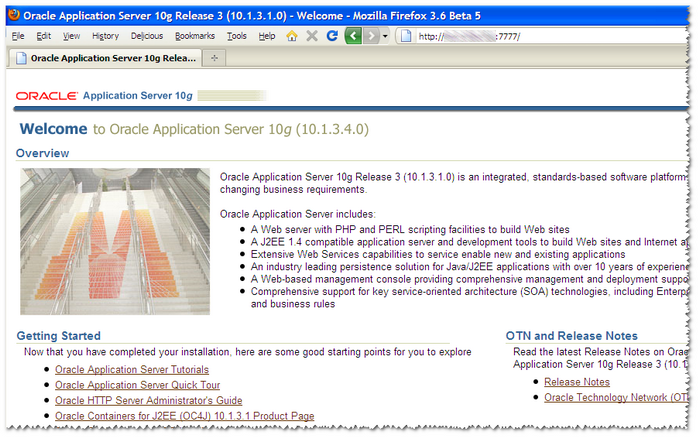Oracle Server 10g

Oracle Application Server 10g - Overview of Oracle HTTP Server Components Page 3 ABSTRACT Oracle Application Server 10g HTTP Server (OHS) provides a web server and also. ORACLE-BASE - Articles about Oracle database 10g new features, application server 10g (AS10g) and grid control 10g.
Installing Oracle Application Server 10 Oracle Application Server Tips by Burleson Consulting Before you can start using Oracle Application Server 10g, you need to get the software installed. With prior versions this has always been a frustrating process of failed attempts, followed by research, followed by another attempt. However for the 10g version of the application server, Oracle has made significant improvements in the installer? Video Er Pro Ipa V1.9. s ability to ensure that the OS is properly configured and to react more gracefully to problems encounter during the installation.
Before you can start using Oracle Application Server 10g, you need to get the software installed. With prior versions this has always been a. Oracle Application Server 10g is an integrated, standards-based software platform that allows organizations of all sizes to be more responsive to changing business.
That said, the application server is still a complicated set of interacting software components and the installation still requires some planning. This chapter will teach you how to install the Oracle Application Server 10g on a UNIX/Linux platform. At the time of this writing, the Windows version of the Oracle Application Server 10g was not yet available. Dcs A10c Warthog Keygen Manager. Planning for the Application Server Installation As with installing any version of Oracle?s application server, some understanding of the components and their interaction is required. As discussed in Chapter 1, the application server is much more than the Apache web server. The application server is the marriage of the web server to the Oracle Containers for Java (OC4J).
If your only requirement is to serve static web pages with servlets accessing a database, the Oracle database installs with a fully functional web server that implements Apache?s Jserv. On the other hand, if you need to configure and load balance 10 web servers connected to a back-end database and your applications require a range of J2EE services, you will need the clustering capabilities and consolidated management that the Oracle Application Server 10g provides. Installation Types The Oracle Application Server 10g has four installation types. 2000 Viking Pop Up Camper Specs more. The smallest mid-tier installation is the J2EE and Web Cache installation type, while the largest is the Business Intelligence and Forms installation. The fourth type of installation is the Oracle Application Server Infrastructure. Installations that include more than J2EE also require the installation of an Infrastructure instance, explained in Chapter 2.
J2EE and Web Cache The J2EE and Web Cache installation includes the Oracle HTTP Server (OHS), the Oracle Containers for Java (OC4J) and the Web Cache. These are the base components and are included in all other installations. The J2EE and Web Cache installation can function in stand-alone mode or be included in an Infrastructure instance?s Farm. When used in the stand-alone mode, the J2EE and Web Cache instance requires manual configuration and management.
When installed as a member of a Farm, the instance is configured within the Oracle Enterprise Manager Application Server Control. Portal and Wireless This installation includes the J2EE and Web Cache installation plus the Oracle Portal and Wireless components. Both components require access to Oracle?s Identity Management and the metadata repository in the Infrastructure instance. Business Intelligence and Forms To install all available components you need to install the Business Intelligence and Forms. This installation type installs the Portal and Wireless components plus Oracle Discoverer, Personalization, Reports Service and Oracle Forms. This middle tier also requires access to an Infrastructure instance. Even though the installation types build on each other, you are not required to configure and start all of the components.
For instance, if your organization uses Oracle Forms, you can install the Business Intelligence and Forms installation type but choose not to configure Portal, Wireless, Discoverer, Personalization and Reports Services. This will allow you to utilize your server resources properly by not starting components that are not needed. This will be discussed later when we walk through the installation. Infrastructure As seen in Chapter 2, many of the application server?s capabilities require the use of an Infrastructure instance. The Infrastructure instance provides the middle tiers access to Oracle?s Internet Directory, Identity Management, and the Metadata Repository. When a middle tier instance is installed it is tied to an Infrastructure instance so the Infrastructure instance must be already installed and running.